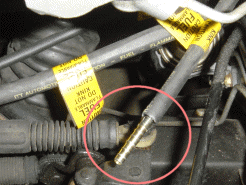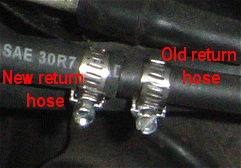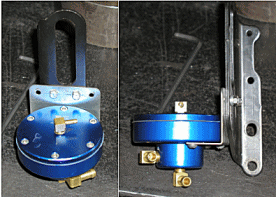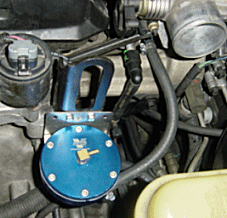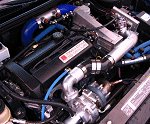

|
Street Class Unlimited Class
DOHC SOHC Ion Updated 1/05 For the most recent list of the fastest five cars click here. |
RRFMU Installby: TitanBoosting a Saturn requires more fuel. Depending how much horsepower you want to produce will dictate the fuel requirements. In this article I will focus on the conservative side of fuel requirements meaning that I will be limiting boost pressures to 5psi. In a setup like this fuel requirements can be met with a relatively small investment in the form of a raising rate fuel management unit (RRFMU). Before we begin there are three variables that must be taken into account fuel pressures, injector size and duty cycle, and maximum power goals. RRFMUs come in several configurations (i.e. 3:1, 6:1, 8:1, etc) based on boost pressures. For example a 6:1 RRFMU means that for every one pound of boost the RRFMU will raise fuel pressure six pounds. This is extremely important when building your fuel system. The stock fuel pressure is 43.5psi using a 6:1 RRFMU 5psi would increase fuel pressure to 73.5psi, which is well above the recommended 60psi safety limit. Anything above 60psi over works the fuel pump and runs the risk of locking the injectors in the closed position. Injector size is critical in providing the proper air/fuel ratio. Make sure that your injectors are flowing properly. I suggest that you remove and clean your injectors before boosting your car. It's a small price to pay for reliability, I would hate to see you lose an engine because one of the injectors wasn't providing enough fuel. I don't recommend that you boost your car using the stock injectors. The extreme fuel pressures and duty cycle needed to provide adequate fuel will be unreliable. Maximum power is always at the front of our minds. More power is always better, right? Well, I have already stated that we are going to remain on the conservative side of boost pressures and at 5psi the RRFMU will be fine. Before you decide on a fuel system solution I recommend that you read the article sizing injectors. This will assist you in choosing the proper sized injectors for your boosted engine. Ok, enough with the background and on to the install! Locate the fuel rail on the top of the engine and follow the fuel rail towards the driver's side where you will see two hoses exiting the fuel rail. The hose closest to the firewall is the return line this is where we will concentrate our efforts. The return line is held in the fuel rail by a blue clip, using needle nose pliers you can depress the tabs and wiggle the hose loose. You will need to cut the return hose line about 4 inches behind the blue clip so you can remove the plastic insert and blue clip.
Then take a razor blade and cut the return line hose off of the plastic insert that is attached to the blue clip. Use the needle nose pliers to help peal the old hose off the plastic insert. Now slide a one-foot section of fuel injection hose* over the plastic insert and fasten with a small hose clamp. The picture depicts what the finished product should look like.
This hose will attach to the "IN" side of the RRFMU. Now you will need to cut some more hose from the return
line depending on where you mount your RRFMU. Once the hose is at
the proper length you will need to splice the old return hose to
the new hose. This splicing is accomplished with a brass fuel union
(autozone PN 355170) and a one-foot section of regular fuel line
hose. Mate the old hose with the new hose and use two hose clamps
to secure the connection. This hose you will attach to the "OUT"
side of the RRFMU.
Finally I lined up the new hoses and cut them to length. Then I attached them to the RRFMU securing them with hose clamps.
Don't forget to check for any leaks around the connections. As you can see with a little time and engineering you can cleanly install an RRFMU and be boosted in no time at all. *Fuel injection hose will hold the pressure of a fuel injected system. This hose normally runs about $5 a foot. As a side note: |
|

